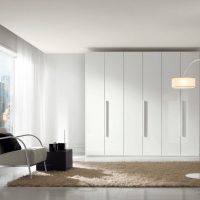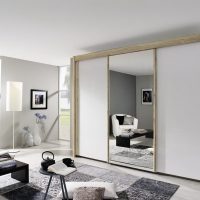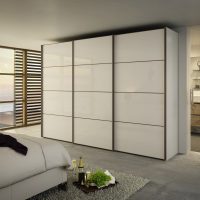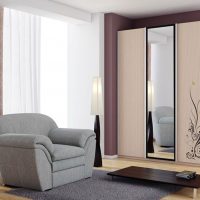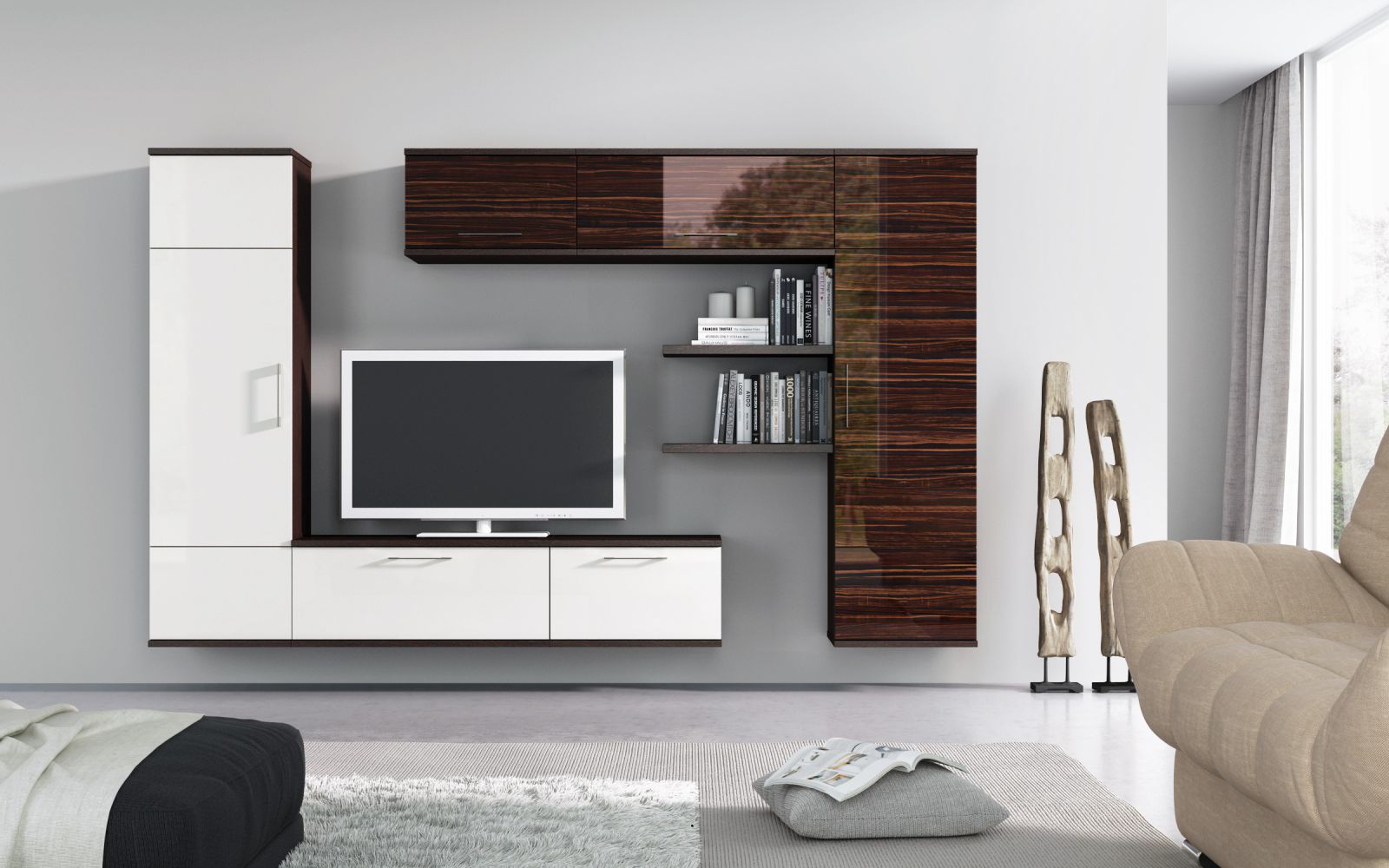Wardrobes. Design, tips and photo examples
Sliding wardrobes are used in both classic and modern living rooms and bedrooms as a convenient storage space for clothes, bedding, personal items, books, dishes and so on, which does not take up a lot of space. The main advantage of this type of furniture is practicality, the absence of swinging elements and the possibility of stylistic expression through decorating with mirror, wooden, plastic and glass inserts, milling, sandblasting and so on (in accordance with the decoration of the room). In addition, stylistic completeness contributes to properly selected fittings.

Sliding wardrobe in a room interior

Large closet with a mirror in the interior of the room
Content
Practicality and spaciousness
First of all, cabinets are selected according to their capacity, overall dimensions, type of construction, internal filling, and so on. Otherwise, it will not fit in the room and will be uncomfortable. Technical characteristics are even more important than the appearance of the furniture, because ease of use depends on them, and not on design.
Materials of manufacture
In the vast majority of cases, sliding wardrobes for rooms in an apartment are made of MDF, and for industrial and technical premises - made of glass and metal. Expensive cabinets can be made of solid wood. The furniture is notable for its heavy weight, the need for constant care, and needs periodic drying and processing.

Sliding wardrobe with a mirror in the interior

Mirrored wardrobe
The doors and the case of sliding wardrobes are covered with facades from solid wood, plastic, PVC, veneer, enamel. The material affects the level of protection against moisture, sunlight, scratches (important for rooms on the sunny side or for children). Good protection is given by plastic, glass and enamel, but PVC film, veneer and solid wood require attention when choosing, especially for the living room. The use of an anti-vandal coating helps to increase the level of protection, which saves from cat scratches, and from children's drawings, and from accidental chips.
Door suspension mechanisms
There are two mechanisms for hanging the doors of the wardrobe — when they are attached to two rails or to one top. The first option is more reliable, but will require frequent cleaning of the gutter lower guide. The second one is simpler and cheaper, but it can become loose over time and stop closing properly, but it’s suitable for the living room. The reliability of the mechanism depends on the strength of the guides, the quantity and quality of the rollers and fasteners. It is recommended to entrust the installation of the sliding wardrobe to specialists or take furniture in the assembly.
The doors in the sliding wardrobes open with a shift relative to each other, while each can have its own guide, or both can be attached to the same rail. It’s much easier to mount one rail, so modern models for living rooms are most often the same.
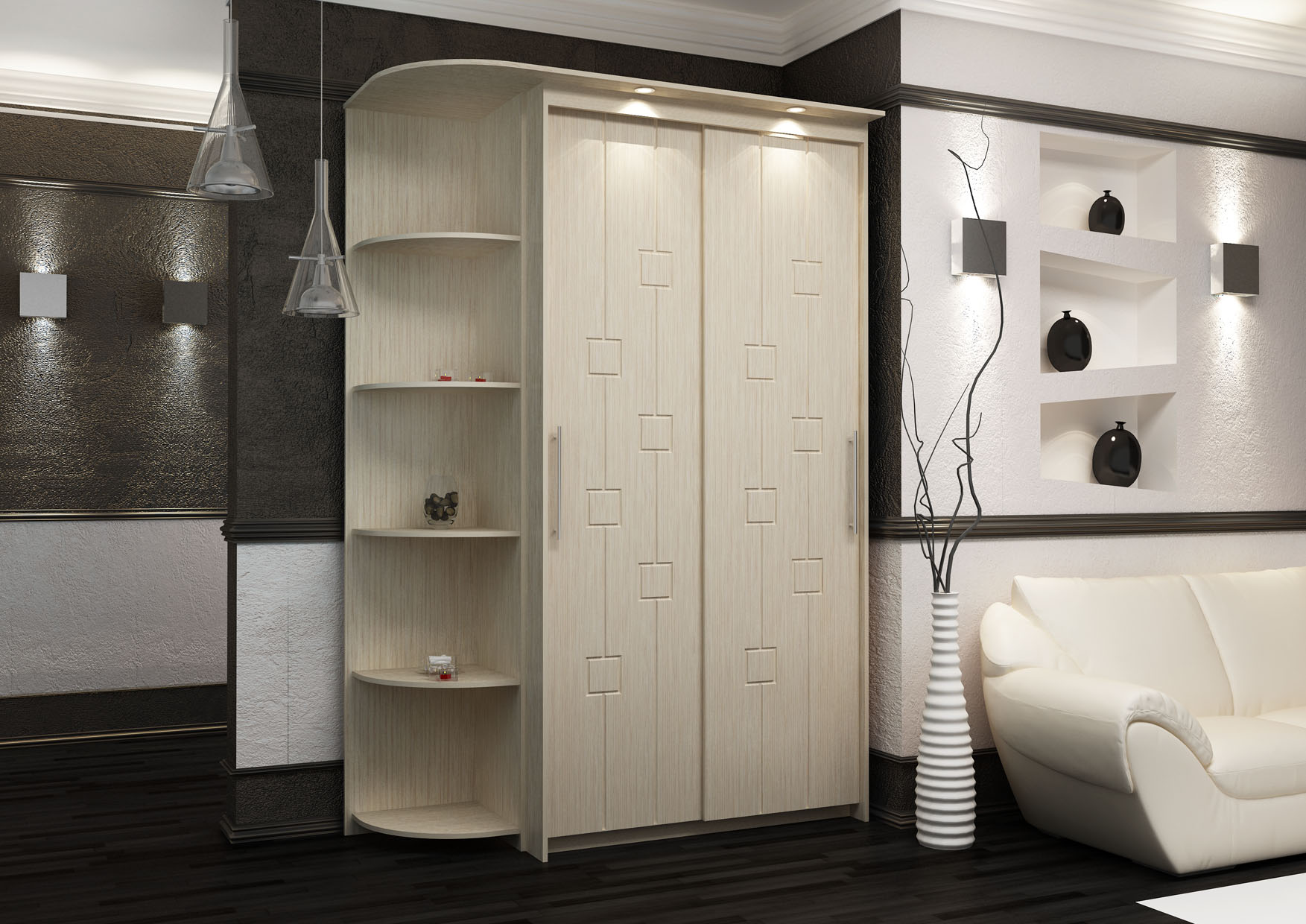
Small closet in the interior

Sliding wardrobe in an interior

Sliding wardrobe with patterns and a mirror
Types of wardrobes by purpose
- Cabinets in the hallway
Cabinets with sliding doors are available in various depths. Narrow are suitable for installation in hallways, medium depth is most often placed in the living room, and deep ones are designed for other rooms.This separation is connected with what kind of things and objects are supposed to be put in the closet. Outerwear and, in some cases, hats, mittens and shoes are stored in hallways in sliding wardrobes. For shoes, however, it is recommended to purchase a special shoe rack. Accordingly, great depth and plentiful internal filling is not necessary. The exception is complex wardrobe cabinets, which can stand both in the hall, and in a special dressing room or in the living room. - Wardrobes
Those sliding wardrobes that are designed to store a large number of clothes have a complex internal content, which includes not only shelves and niches, but also drawers for underwear, jewelry, cosmetics, and everything that should be stored in the room. Put them in the living room or bedroom. The upper part of the wardrobe is reserved for hats and things that are rarely used, but take up a lot of space in the room, as well as clothes not used in the season. If the wardrobe is in the bedroom, then pillows and similar items are placed upstairs. The middle part of the wardrobe is designed for hanging and unfolding seasonally appropriate clothes, it is equipped with niches with a bar, hooks, shelves and drawers. When calculating the internal content, it is necessary to take into account the amount of clothing that requires hanging on the shoulders, especially if there are a large number of shirts, dresses, business suits. Lower niches are used to put other necessary things there (shoes, bedding, children's toys and so on).
Large fitted wardrobe

Sliding wardrobe in the hallway interior
- Sliding bookcases
This is a rather rare variety, since it is more convenient to store books in the living room on the shelves of glazed shelves. Where more often such furniture is placed in a room to put objects in them that are not needed very often and which you want to hide from prying eyes. Manufacturers like to understaff with such small cabinets the walls and racks for living rooms. - Built-in wardrobes
Built-in wardrobes differ from the others in the absence of a rear wall and the inability to install outside a specially designated niche for it. The dimensions, internal content and finish of the built-in wardrobe are the same as those of non-built models.
Subtle stylistic moment
Since any sliding wardrobes, due to their size and placement in the room, are considered a large form, when choosing the interior design of an apartment, you need to pay no less attention to their design than the wall in the living room, kitchen unit and sofas. In its stylistic function, the wardrobe can be similar to wallpaper or walls for the living room (that is, to make up the background), or it can be an accent that attracts attention. In any case, the design of the wardrobe should not go out of style.

Small closet in the interior
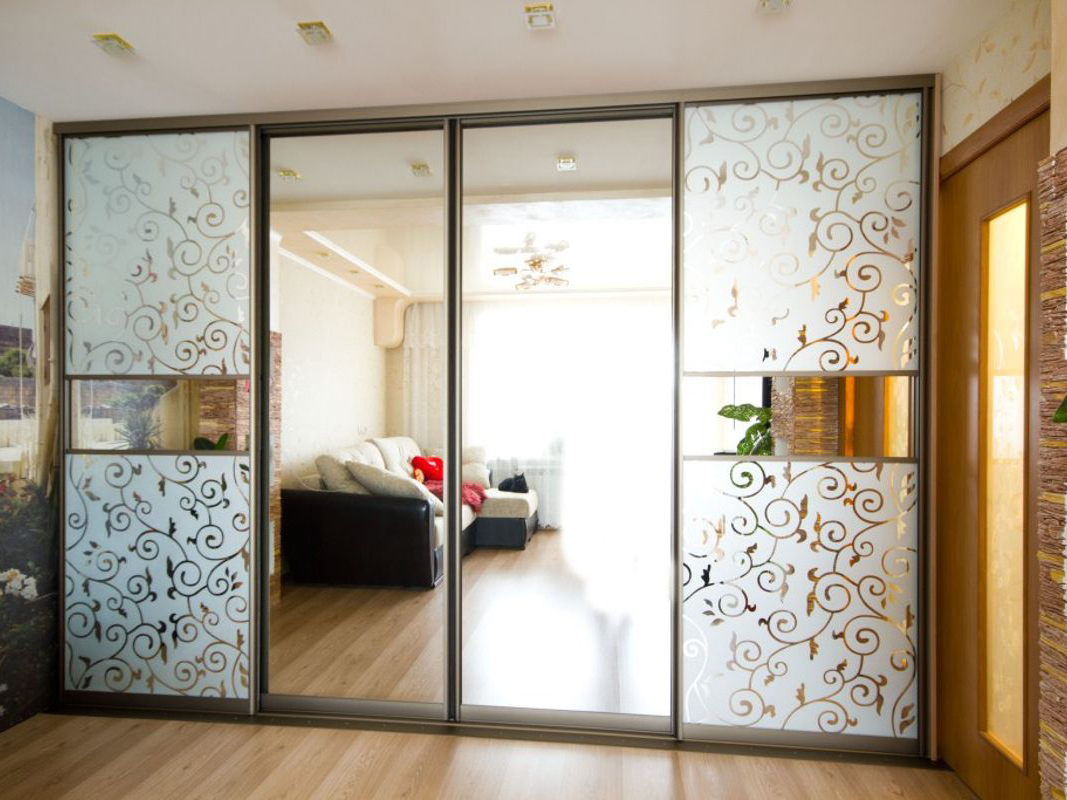
Room design with wardrobe

Mirrored wardrobe
Provence
The Provence style in furniture belongs to the category of rustic and is characterized primarily by the abundance of white. Characteristic features of Provence:
- trellised facades;
- carved legs;
- plant motifs for milling carvings, stained glass or sandblasting.
Cabinets in the interior of Provence should be lightweight, despite their size. This is facilitated by the abundance of voids (the same lattices), mirror inserts, carved decoration of the upper part, resembling a drop-down flower. Neo Provence is a peculiar branch of minimalism and hi-tech, when a white wardrobe made of modern materials is decorated with flowers or vines. It is permissible to use not only an array, but also veneer and even enamel.

Sliding wardrobe in a room interior

Sliding wardrobe in an interior
Scandinavian
Typically, the Scandinavian style of furniture is associated with a hospital room or renovation in the spirit of the nineties, and not with a beautiful living room, but initially it was based on the use of natural colors - natural wood, white,gray. A feature of the wardrobe in the Scandinavian interior is its simplicity, even rudeness. This is not a Provence where grace and lightness are needed, massiveness is permissible here. The facade for the wardrobe in the Scandinavian style is better to choose either from an array or veneered. A good option, emphasizing the respect for the environment (and the Scandinavians love it), is a facade made of eco-veneer.

Large mirrored wardrobe

Sliding wardrobe with a mirror in the interior of the room
Classic
Classic style is one of the most difficult. Wardrobes in the classic interior play a very prominent role, so they should by no means be of a variety, especially in the living room. And there should be a lot of them. Moreover, not every apartment fits the classics, because in order to later live in this room and not to “suffocate”, it is necessary that the room be large, with high ceilings and wide windows.
Sliding wardrobes in a classic interior are installed along the entire or almost the entire wall and make up a single ensemble of furniture. Mirror inserts here are unacceptable, only an array of natural wood, stained glass and carving or milling. The outlines and the type of lines of the wardrobe depend on the specific design of the furniture (classic, neoclassical, empire, baroque, rococo and so on). It is the classic that assumes following the principle of the golden section in space and forms, a rather modest design, the absence of monograms and even somewhat less massive than all other options.

Solid wood wardrobe in the room interior

Sliding wardrobe with patterns in the interior of the room
The most “massive” of the classical ones is the Empire style in the spirit of the Roman emperors with its heavy folds, pomp, warlike motives, gold and scarlet.
Sliding wardrobes in an interior will occupy a lot of space in the apartment. You can decorate the wardrobe with the spirit of empire by carving with the image of chariots, laurel, swords, spears, objects of military glory. Colors - black, red, gold, dark wood. The living room may look gloomy, but spectacular.
The most artsy is Baroque. You can afford absolutely any vignettes, stained-glass windows, "little balls", ribbons, a variety of colors (it is better to take pastel colors) on the body and doors of the wardrobe. However, it is impractical (cleaning in such a living room will take a lot of time) and requiring a fair taste in order not to overdo it (although this would seem to be impossible).
Rococo is also an elaborate version of the design, but it is a little simpler and differs in the smoothness of lines and marine theme (waves, rocky shells, Aphrodite from foam born), as well as the frequent use of cherubs as decorations.

White wardrobe in the interior of the room

Small closet in room design
Modern
Modern styles are also very diverse. The main thing that distinguishes them from the classical ones is simplicity, even somewhat provocative, a minimum of occupied space, the ability to use any colors in the design of sliding wardrobes and accessories. Room accessories should be relatively simple and made of metal, glass or plastic, but the tree is better left for the classics. This also applies to walls.
Sliding wardrobe in a modern interior can be from any material, including plastic. Manufacturers offer quite a few variations of minimalistic milling for such furniture, ranging from snakes to abstractions. Colors - any. At all. An exception is the wardrobe in the hi-tech interior. This style is demanding on the color scheme and allows only white, black, steel colors, glass, metal, sometimes pure red or purplish.
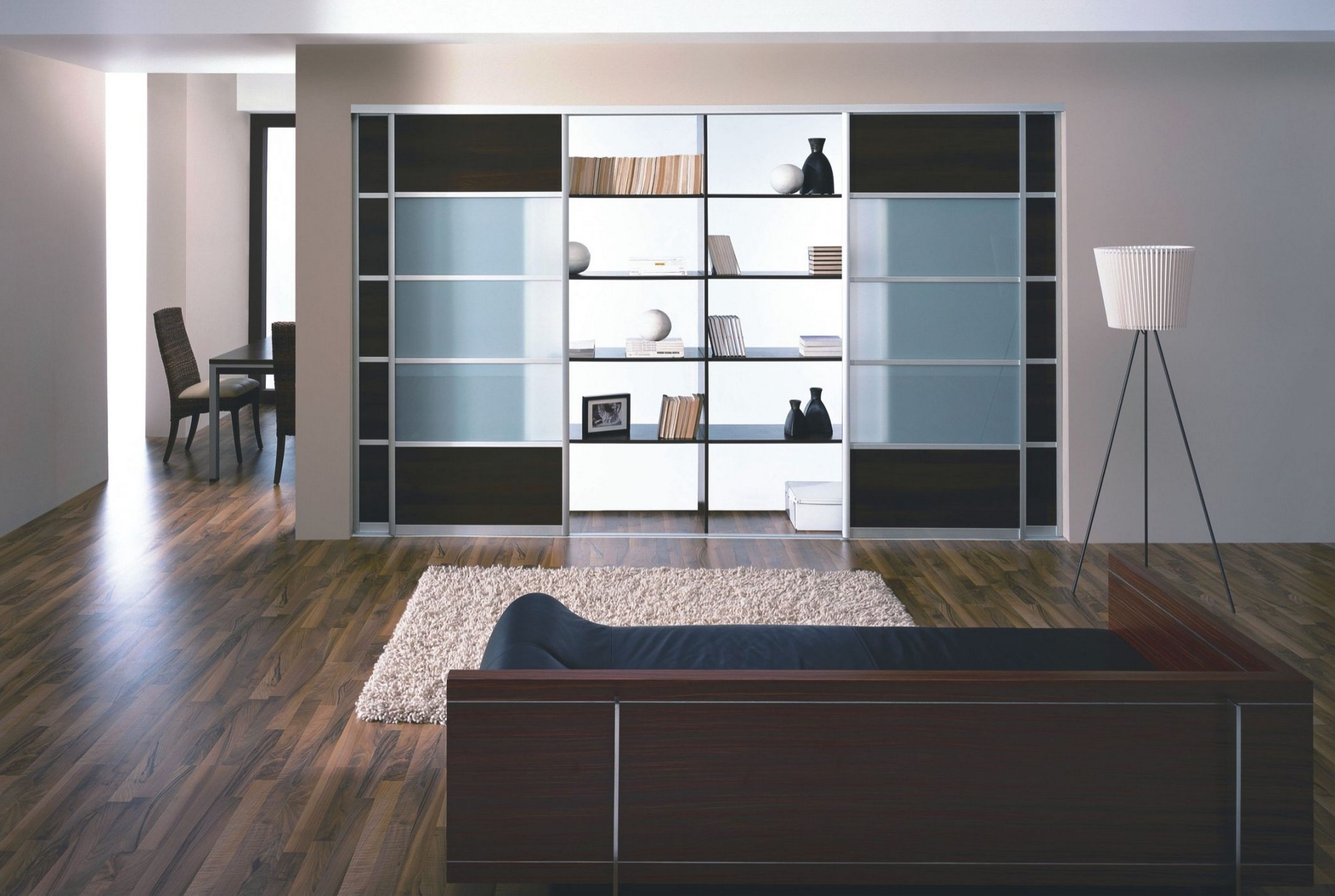
Sliding wardrobe in an interior
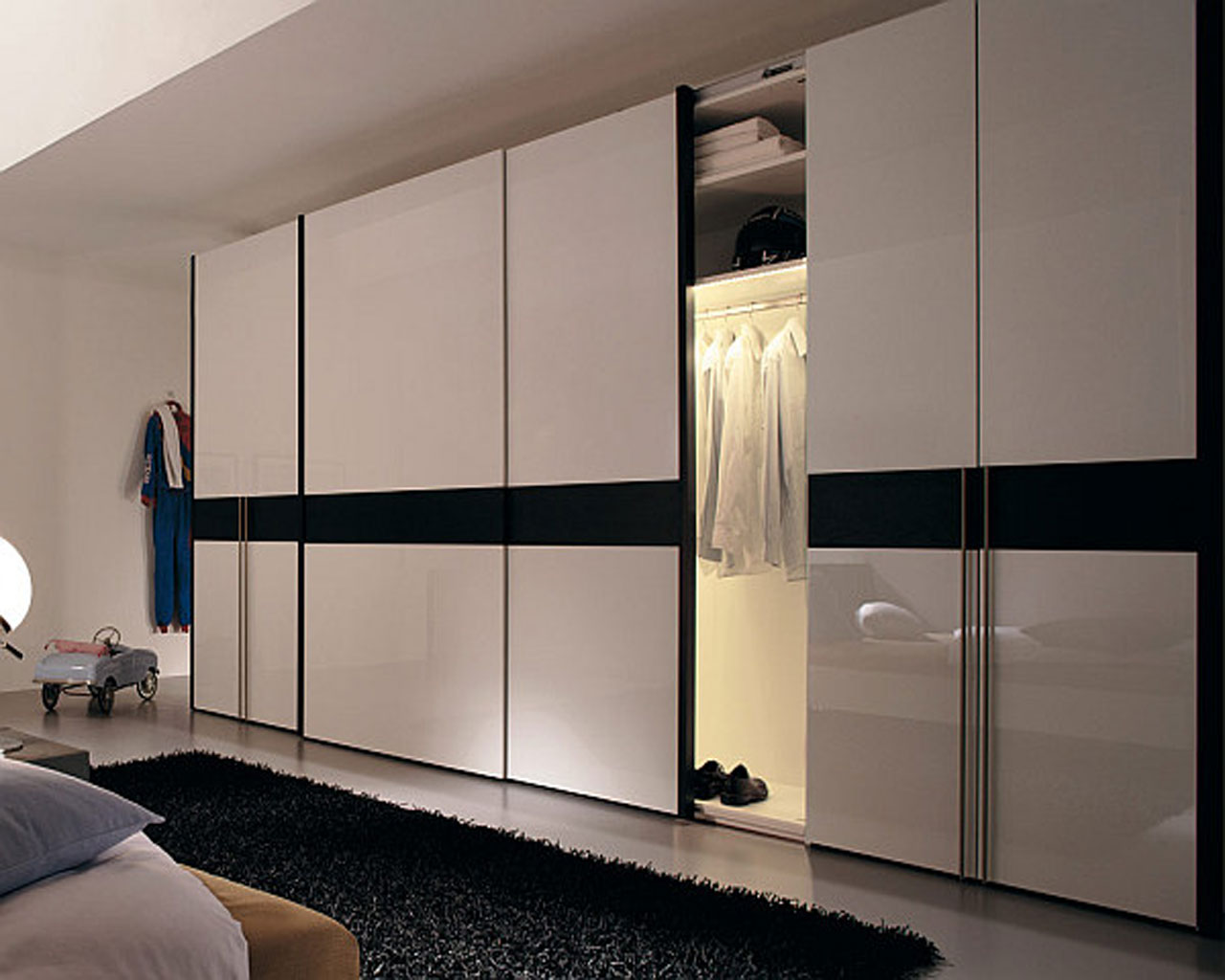
Large closet
Accessories and fittings
The choice of fittings for sliding wardrobes is often accompanied by serious problems, because it must coincide externally with the desired. This applies to pens, mainly.The type of compartment door does not imply the use of push handles, only brackets, or even their complete absence (to open just with the palm of your hand), and this option is not very suitable for classics, where the handle is an accent that determines whether the sliding wardrobe belongs to one or another stylistic direction . But if there is a choice to take the option with a bad pen or no pens at all, then it is better to dwell on the latter.

Design of a sliding wardrobe with a mirror

Large closet in the interior of the room

Sliding wardrobe in an interior
Mirror doors are literally the visiting card of hi-tech sliding wardrobes, but they can also be used in other directions of design. Sandblasting is done directly at the factory according to the provided sketch. Without a picture, they simply visually increase the space in the living room or bedroom and contribute to improving the lighting of the room.
Video: Overview of the sliding wardrobe with integrated workstation








